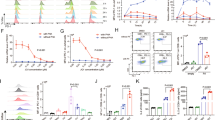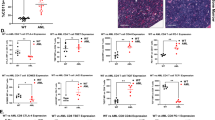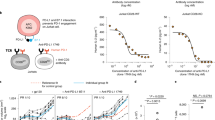Abstract
Bromo- and extra-terminal domain (BET) inhibitors represent potential therapeutic approaches in solid and hematological malignancies that are currently analyzed in several clinical trials. Additionally, BET are involved in the epigenetic regulation of immune responses by macrophages and dendritic cells (DCs), that play a central role in the regulation of immune responses, indicating that cancer treatment with BET inhibitors can promote immunosuppressive effects. The aim of this study was to further characterize the effects of selective BET inhibition by JQ1 on DC maturation and DC-mediated antigen-specific T-cell responses. Selective BET inhibition by JQ1 impairs LPS-induced DC maturation and inhibits the migrational activity of DCs, while antigen uptake is not affected. JQ1-treated DCs show reduced ability to induce antigen-specific T-cell proliferation. Moreover, antigen-specific T cells co-cultured with JQ1-treated DCs exhibit an inactive phenotype and reduced cytokine production. JQ1-treated mice show reduced immune responses in vivo to sublethal doses of LPS, characterized by a reduced white blood cell count, an immature phenotype of splenic DCs and T cells and lower blood levels of IL-6. In our study, we demonstrate that selective BET inhibition by JQ1, a drug currently tested in clinical trials for malignant diseases, has profound effects on DC maturation and DC-mediated antigen-specific T-cell responses. These immunosuppressive effects can result in the induction of possible infectious side effects in cancer treatments. In addition, based on our results, these compounds should not be used in combinatorial regimes using immunotherapeutic approaches such as check point inhibitors, T-cell therapies, or vaccines.







Similar content being viewed by others
Abbreviations
- BET:
-
Bromo- and extra-terminal domain
- BMDCs:
-
Bone marrow-derived dendritic cells
- BRD4:
-
Bromodomain containing protein 4
- CCL:
-
C–C motif chemokine ligand
- CCR:
-
C–C chemokine receptor type
- CFSE:
-
Carboxyfluorescein succinimidyl ester
- DCs:
-
Dendritic cells
- DMSO:
-
Dimethyl sulfoxide
- ERK:
-
Extracellular signal-regulated kinases
- FACS:
-
Fluorescence-activated cell sorter
- FBS:
-
Fetal bovine serum
- FITC:
-
Fluorescein isothiocyanate
- GAPDH:
-
Glyceraldehyde-3-phosphate dehydrogenase
- GM-CSF:
-
Granulocyte-macrophage colony-stimulating factor
- HLA-DR:
-
Human leukocyte antigen DR
- IL-1:
-
Interleukin-1
- IL-10:
-
Interleukin-10
- IL-12:
-
Interleukin-12
- IL-4:
-
Interleukin-4
- IL-6:
-
Interleukin-6
- INFγ:
-
Interferon gamma
- LPS:
-
Lipopolysaccharide
- mAb:
-
Monoclonal antibody
- MACS:
-
Magnetic cell separation
- MAPK:
-
Mitogen-activated protein kinases
- MHC:
-
Major histocompatibility complex
- MIP-3β:
-
Macrophage inflammatory protein-3 beta
- MoDCs:
-
Monocyte-derived dendritic cells
- NF-κB:
-
Nuclear factor kappa-light-chain-enhancer of activated B cells
- OVA:
-
Ovalbumin
- PD-L1:
-
Programmed cell death 1 ligand 1
- RT qPCR:
-
Real-time quantitative polymerase chain reaction
- STAT:
-
Signal transducer and activator of transcription
- TLR:
-
Toll-like receptor
- TNFα:
-
Tumor necrosis factor alpha
- TNFβ:
-
Tumor necrosis factor beta
- β-ME:
-
Beta-mercaptoethanol
References
Shi X, Liu C, Liu B, Chen J, Wu X, Gong W (2018) JQ1: a novel potential therapeutic target. Pharmazie 73(9):491–493. https://doi.org/10.1691/ph.2018.8480
Filippakopoulos P, Qi J, Picaud S, Shen Y, Smith WB, Fedorov O, Morse EM, Keates T, Hickman TT, Felletar I, Philpott M, Munro S, McKeown MR, Wang Y, Christie AL, West N, Cameron MJ, Schwartz B, Heightman TD, La Thangue N, French CA, Wiest O, Kung AL, Knapp S, Bradner JE (2010) Selective inhibition of BET bromodomains. Nature 468(7327):1067–1073. https://doi.org/10.1038/nature09504
Delmore JE, Issa GC, Lemieux ME, Rahl PB, Shi J, Jacobs HM, Kastritis E, Gilpatrick T, Paranal RM, Qi J, Chesi M, Schinzel AC, McKeown MR, Heffernan TP, Vakoc CR, Bergsagel PL, Ghobrial IM, Richardson PG, Young RA, Hahn WC, Anderson KC, Kung AL, Bradner JE, Mitsiades CS (2011) BET bromodomain inhibition as a therapeutic strategy to target c-Myc. Cell 146(6):904–917. https://doi.org/10.1016/j.cell.2011.08.017
French CA, Miyoshi I, Aster JC, Kubonishi I, Kroll TG, Dal Cin P, Vargas SO, Perez-Atayde AR, Fletcher JA (2001) BRD4 bromodomain gene rearrangement in aggressive carcinoma with translocation t(15;19). Am J Pathol 159(6):1987–1992. https://doi.org/10.1016/S0002-9440(10)63049-0
Filippakopoulos P, Knapp S (2014) Targeting bromodomains: epigenetic readers of lysine acetylation. Nat Rev Drug Discov 13(5):337–356. https://doi.org/10.1038/nrd4286
Nicodeme E, Jeffrey KL, Schaefer U, Beinke S, Dewell S, Chung C-W, Chandwani R, Marazzi I, Wilson P, Coste H, White J, Kirilovsky J, Rice CM, Lora JM, Prinjha RK, Lee K, Tarakhovsky A (2010) Suppression of inflammation by a synthetic histone mimic. Nature 468(7327):1119–1123. https://doi.org/10.1038/nature09589
Palucka K, Banchereau J (2012) Cancer immunotherapy via dendritic cells. Nat Rev Cancer 12(4):265–277. https://doi.org/10.1038/nrc3258
Restifo NP, Dudley ME, Rosenberg SA (2012) Adoptive immunotherapy for cancer: harnessing the T cell response. Nat Rev Immunol 12(4):269–281. https://doi.org/10.1038/nri3191
Banchereau J, Briere F, Caux C, Davoust J, Lebecque S, Liu YJ, Pulendran B, Palucka K (2000) Immunobiology of dendritic cells. Annu Rev Immunol. https://doi.org/10.1146/annurev.immunol.18.1.767
Banchereau J, Steinman RM (1998) Dendritic cells and the control of immunity. Nature 392(6673):245–252. https://doi.org/10.1038/32588
Sallusto F, Lanzavecchia A (1994) Efficient presentation of soluble antigen by cultured human dendritic cells is maintained by granulocyte/macrophage colony-stimulating factor plus interleukin 4 and downregulated by tumor necrosis factor alpha. J Exp Med 179(4):1109–1118
Takeda K, Kaisho T, Akira S (2003) Toll-like receptors. Annu Rev Immunol. https://doi.org/10.1146/annurev.immunol.21.120601.141126
West MA, Wallin RPA, Matthews SP, Svensson HG, Zaru R, Ljunggren H-G, Prescott AR, Watts C (2004) Enhanced dendritic cell antigen capture via toll-like receptor-induced actin remodeling. Science 305(5687):1153–1157. https://doi.org/10.1126/science.1099153
Platt CD, Ma JK, Chalouni C, Ebersold M, Bou-Reslan H, Carano RAD, Mellman I, Delamarre L (2010) Mature dendritic cells use endocytic receptors to capture and present antigens. Proc Natl Acad Sci USA 107(9):4287–4292. https://doi.org/10.1073/pnas.0910609107
Knight SC, Iqball S, Roberts MS, Macatonia S, Bedford PA (1998) Transfer of antigen between dendritic cells in the stimulation of primary T cell proliferation. Eur J Immunol 28(5):1636–1644. https://doi.org/10.1002/(SICI)1521-4141(199805)28:05%3c1636:AID-IMMU1636%3e3.0.CO;2-9
Campbell JJ, Butcher EC (2000) Chemokines in tissue-specific and microenvironment-specific lymphocyte homing. Curr Opin Immunol 12(3):336–341
Kapsenberg ML (2003) Dendritic-cell control of pathogen-driven T-cell polarization. Nat Rev Immunol 3(12):984–993. https://doi.org/10.1038/nri1246
Appleman LJ, Berezovskaya A, Grass I, Boussiotis VA (2000) CD28 costimulation mediates T cell expansion via IL-2-independent and IL-2-dependent regulation of cell cycle progression. J Immunol 164(1):144–151
Cheng J, Montecalvo A, Kane LP (2011) Regulation of NF-kappaB induction by TCR/CD28. Immunol Res 50(2–3):113–117. https://doi.org/10.1007/s12026-011-8216-z
Watts TH (2005) TNF/TNFR family members in costimulation of T cell responses. Annu Rev Immunol. https://doi.org/10.1146/annurev.immunol.23.021704.115839
Kalinski P, Hilkens CM, Wierenga EA, Kapsenberg ML (1999) T-cell priming by type-1 and type-2 polarized dendritic cells: the concept of a third signal. Immunol Today 20(12):561–567
Steinman RM (2003) The control of immunity and tolerance by dendritic cell. Pathol Biol (Paris) 51(2):59–60
Matheu MP, Sen D, Cahalan MD, Parker I (2008) Generation of bone marrow derived murine dendritic cells for use in 2-photon imaging. J Vis Exp. https://doi.org/10.3791/773
Heine A, Held SAE, Daecke SN, Wallner S, Yajnanarayana SP, Kurts C, Wolf D, Brossart P (2013) The JAK-inhibitor ruxolitinib impairs dendritic cell function in vitro and in vivo. Blood 122(7):1192–1202. https://doi.org/10.1182/blood-2013-03-484642
Appel S, Mirakaj V, Bringmann A, Weck MM, Grünebach F, Brossart P (2005) PPAR-gamma agonists inhibit toll-like receptor-mediated activation of dendritic cells via the MAP kinase and NF-kappaB pathways. Blood 106(12):3888–3894. https://doi.org/10.1182/blood-2004-12-4709
Weck MM, Appel S, Werth D, Sinzger C, Bringmann A, Grünebach F, Brossart P (2008) hDectin-1 is involved in uptake and cross-presentation of cellular antigens. Blood 111(8):4264–4272. https://doi.org/10.1182/blood-2006-10-051375
Muller S, Filippakopoulos P, Knapp S (2011) Bromodomains as therapeutic targets. Expert Rev Mol Med. https://doi.org/10.1017/s1462399411001992
Pardoll DM (2012) The blockade of immune checkpoints in cancer immunotherapy. Nat Rev Cancer 12(4):252–264. https://doi.org/10.1038/nrc3239
Sun Y, Wang Y, Toubai T, Oravecz-Wilson K, Liu C, Mathewson N, Wu J, Rossi C, Cummings E, Wu D, Wang S, Reddy P (2015) BET bromodomain inhibition suppresses graft-versus-host disease after allogeneic bone marrow transplantation in mice. Blood 125(17):2724–2728. https://doi.org/10.1182/blood-2014-08-598037
Schilderink R, Bell M, Reginato E, Patten C, Rioja I, Hilbers FW, Kabala PA, Reedquist KA, Tough DF, Tak PP, Prinjha RK, de Jonge WJ (2016) BET bromodomain inhibition reduces maturation and enhances tolerogenic properties of human and mouse dendritic cells. Mol Immunol. https://doi.org/10.1016/j.molimm.2016.09.010
Toniolo PA, Liu S, Yeh JE, Moraes-Vieira PM, Walker SR, Vafaizadeh V, Barbuto JAM, Frank DA (2015) Inhibiting STAT5 by the BET bromodomain inhibitor JQ1 disrupts human dendritic cell maturation. J Immunol 194(7):3180–3190. https://doi.org/10.4049/jimmunol.1401635
Belkina AC, Nikolajczyk BS, Denis GV (2013) BET protein function is required for inflammation: Brd2 genetic disruption and BET inhibitor JQ1 impair mouse macrophage inflammatory responses. J Immunol 190(7):3670–3678. https://doi.org/10.4049/jimmunol.1202838
Meng S, Zhang L, Tang Y, Tu Q, Zheng L, Yu L, Murray D, Cheng J, Kim SH, Zhou X, Chen J (2014) BET inhibitor JQ1 blocks inflammation and bone destruction. J Dent Res 93(7):657–662. https://doi.org/10.1177/0022034514534261
Sun Y, Huang J, Song K (2015) BET protein inhibition mitigates acute myocardial infarction damage in rats via the TLR4/TRAF6/NF-κB pathway. Exp Ther Med 10(6):2319–2324. https://doi.org/10.3892/etm.2015.2789
Wienerroither S, Rauch I, Rosebrock F, Jamieson AM, Bradner J, Muhar M, Zuber J, Muller M, Decker T (2014) Regulation of NO synthesis, local inflammation, and innate immunity to pathogens by BET family proteins. Mol Cell Biol 34(3):415–427. https://doi.org/10.1128/MCB.01353-13
Liu S, Walker SR, Nelson EA, Cerulli R, Xiang M, Toniolo PA, Qi J, Stone RM, Wadleigh M, Bradner JE, Frank DA (2014) Targeting STAT5 in hematologic malignancies through inhibition of the bromodomain and extra-terminal (BET) bromodomain protein BRD2. Mol Cancer Ther 13(5):1194–1205. https://doi.org/10.1158/1535-7163.MCT-13-0341
Lehtonen A, Matikainen S, Miettinen M, Julkunen I (2002) Granulocyte-macrophage colony-stimulating factor (GM-CSF)-induced STAT5 activation and target-gene expression during human monocyte/macrophage differentiation. J Leukoc Biol 71(3):511–519
Heine A, Held SAE, Daecke SN, Riethausen K, Kotthoff P, Flores C, Kurts C, Brossart P (2015) The VEGF-receptor inhibitor axitinib impairs dendritic cell phenotype and function. PLoS ONE 10(6):e0128897. https://doi.org/10.1371/journal.pone.0128897
Arrighi JF, Rebsamen M, Rousset F, Kindler V, Hauser C (2001) A critical role for p38 mitogen-activated protein kinase in the maturation of human blood-derived dendritic cells induced by lipopolysaccharide, TNF-alpha, and contact sensitizers. J Immunol 166(6):3837–3845. https://doi.org/10.4049/jimmunol.166.6.3837
Wang H, Huang W, Liang M, Shi Y, Zhang C, Li Q, Liu M, Shou Y, Yin H, Zhu X, Sun X, Hu Y, Shen Z (2018) (+)-JQ1 attenuated LPS-induced microglial inflammation via MAPK/NFκB signaling. Cell Biosci. https://doi.org/10.1186/s13578-018-0258-7
Sallusto F, Schaerli P, Loetscher P, Schaniel C, Lenig D, Mackay CR, Qin S, Lanzavecchia A (1998) Rapid and coordinated switch in chemokine receptor expression during dendritic cell maturation. Eur J Immunol 28(9):2760–2769. https://doi.org/10.1002/(SICI)1521-4141(199809)28:09%3c2760:AID-IMMU2760%3e3.0.CO;2-N
Liu Z, Roche PA (2015) Macropinocytosis in phagocytes: regulation of MHC class-II-restricted antigen presentation in dendritic cells. Front Physiol. https://doi.org/10.3389/fphys.2015.00001
Mele DA, Salmeron A, Ghosh S, Huang H-R, Bryant BM, Lora JM (2013) BET bromodomain inhibition suppresses TH17-mediated pathology. J Exp Med 210(11):2181–2190. https://doi.org/10.1084/jem.20130376
Fu F, Li Y, Qian S, Lu L, Chambers FD, Starzl TE, Fung JJ, Thomson AW (1997) Costimulatory molecule-deficient dendritic cell progenitors induce T cell hyporesponsiveness in vitro and prolong the survival of vascularized cardiac allografts. Transpl Proc 29(1–2):1310
Georgiev P, Wang Y, Muise ES, Bandi ML, Blumenschein W, Sathe M, Pinheiro EM, Shumway SD (2019) BET bromodomain inhibition suppresses human T cell function. Immunohorizons 3(7):294–305. https://doi.org/10.4049/immunohorizons.1900037
Kaplan MH, Daniel C, Schindler U, Grusby MJ (1998) Stat proteins control lymphocyte proliferation by regulating p27Kip1 expression. Mol Cell Biol 18(4):1996–2003
Hogg SJ, Vervoort SJ, Deswal S, Ott CJ, Li J, Cluse LA, Beavis PA, Darcy PK, Martin BP, Spencer A, Traunbauer AK, Sadovnik I, Bauer K, Valent P, Bradner JE, Zuber J, Shortt J, Johnstone RW (2017) BET-bromodomain inhibitors engage the host immune system and regulate expression of the immune checkpoint ligand PD-L1. Cell Rep 18(9):2162–2174. https://doi.org/10.1016/j.celrep.2017.02.011
Salio M, Cella M, Suter M, Lanzavecchia A (1999) Inhibition of dendritic cell maturation by herpes simplex virus. Eur J Immunol 29(10):3245–3253. https://doi.org/10.1002/(SICI)1521-4141(199910)29:10%3c3245:AID-IMMU3245%3e3.0.CO;2-X
Funding
This study was in part supported by a scholarship awarded to Jens Nolting from Else Kröner-Fresenius-Stifung.
Author information
Authors and Affiliations
Contributions
Conceptualization: Jens Nolting; methodology: Jens Nolting; formal analysis and investigation: Niklas Remke, Savita Bisht, and Sebastian Oberbeck; writing– original draft preparation: Niklas Remke; writing—review and editing: Jens Nolting and Peter Brossart; funding acquisition: Jens Nolting; supervision: Peter Brossart.
Corresponding author
Ethics declarations
Conflict of interest
The authors declare that they have no conflict of interest.
Ethical approval
Animal experiments described here comply with Directive 2010/63/EU and were approved by the government of the state of North Rhine-Westphalia. Mice were maintained according to the guidelines of the Federation of European Laboratory Animal Science Associations (FELASA). The studies were approved by the EC (131/11, 173/09).
Animal source
The strains C57BL/6-Tg(TcraTcrb)1100Mjb/Crl (OT I Mouse) and C57BL/6-Tg(TcraTcrb)425Cbn/Crl (OT II Mouse) were generously provided by J.G. van den Boorn (Dept. of Clinical Chemistry and Clinical Pharmacology, University Hospital Bonn, Bonn, Germany). Each strain used in the study was originally supplied by Charles River.
Additional information
Publisher's Note
Springer Nature remains neutral with regard to jurisdictional claims in published maps and institutional affiliations.
Electronic supplementary material
Below is the link to the electronic supplementary material.
Rights and permissions
About this article
Cite this article
Remke, N., Bisht, S., Oberbeck, S. et al. Selective BET-bromodomain inhibition by JQ1 suppresses dendritic cell maturation and antigen-specific T-cell responses. Cancer Immunol Immunother 70, 107–121 (2021). https://doi.org/10.1007/s00262-020-02665-x
Received:
Accepted:
Published:
Issue Date:
DOI: https://doi.org/10.1007/s00262-020-02665-x




